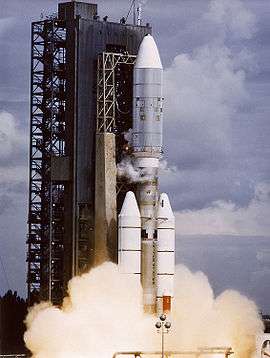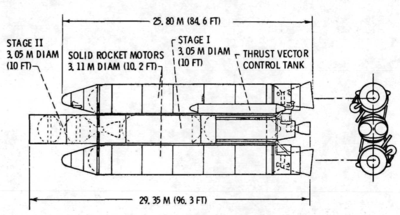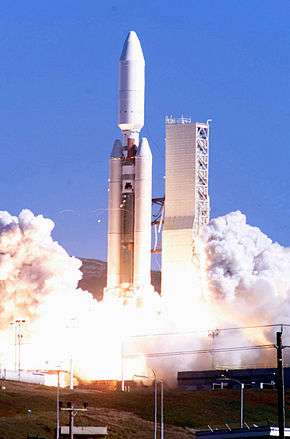Titan IIIE
 Launch of a Titan IIIE with Voyager 2 | |
| Function | Expendable launch system |
|---|---|
| Manufacturer |
Martin Marietta Convair Aerospace Division of General Dynamics (prime contractor for the third stage Centaur D-1T) |
| Country of origin | United States |
| Size | |
| Height | 48.8 meters (160 ft)[1]:142 |
| Diameter | 3.05 meters (10.0 ft)}[1]:142 |
| Mass | 632,970 kilograms (1,395,460 lb) |
| Stages | 3 with an option for 4 |
| Capacity | |
| Payload to Low Earth orbit | 15,400 kilograms (34,000 lb) |
| Payload to Heliocentric orbit (TMI) | 3,700 kilograms (8,200 lb) |
| Associated rockets | |
| Family | Titan |
| Launch history | |
| Status | Retired |
| Launch sites |
Launch Complex 41 Cape Canaveral Air Force Station Cape Canaveral, Florida |
| Total launches | 7 |
| Successes | 6 |
| Failures | 1 |
| First flight | February 11, 1974 |
| Last flight | September 5, 1977 |
| Notable payloads |
Voyager (1 / 2) Viking (1 / 2) Helios (A / B) |
| Zero stage – Solid Rocket Boosters | |
| Engines |
UA1205 Chemical Systems Division of United Technologies[1]:142 (two, five-segment, strap-on boosters) |
| Thrust |
5,339 kilonewtons (1,200,000 lbf) (each booster)[2]:2-1 |
| Specific impulse | 266 sec[2]:2-1 |
| Burn time | 117 seconds[2]:1-2 |
| First stage – Core First Stage | |
| Engines |
LR87-11 (two) Aerojet[1]:142 |
| Thrust |
2,313 kilonewtons (520,000 lbf)[2]:2-1 or 2,091 kilonewtons (470,000 lbf)[1]:142 |
| Specific impulse | 301.1 sec[2]:2-1 |
| Burn time | 146 seconds[2]:1-2 |
| Fuel |
Aerozine 50 Dinitrogen tetroxide[2]:2-1 |
| Second stage – Core Second Stage | |
| Engines |
LR91-11 (one)) Aerojet[1]:142 |
| Thrust |
449 kilonewtons (101,000 lbf)[2]:2-1 or 444.8 kilonewtons (100,000 lbf)[1]:142 |
| Specific impulse | 318.7 sec[2]:2-1 |
| Burn time | 210 seconds[2]:1-3 |
| Fuel |
Aerozine 50 Dinitrogen tetroxide[2]:2-1 |
| Third stage – Centaur D-1T | |
| Engines |
RL10A-3 (two) Pratt & Whitney Aircraft Division of the United Aircraft Corporation[2]:1-6 |
| Thrust | 66.7 kilonewtons (15,000 lbf) (each engine)[1]:142 |
| Specific impulse | 444 sec |
| Burn time | 470 seconds |
| Fuel |
Liquid hydrogen Liquid oxygen[2]:1-4 |
| Fourth stage – Star 37E | |
| Engines |
1 solid Thiokol |
| Thrust | 68 kilonewtons (15,000 lbf) |
| Specific impulse | 283.6 sec[3] |
| Burn time | 42 seconds |
| Fuel | Solid |
The Titan IIIE or Titan 3E, also known as the Titan III-Centaur, was an American expendable launch system. Launched seven times between 1974 and 1977,[4] it enabled several high-profile NASA missions, including the Voyager and Viking planetary probes and the joint West Germany-U.S. Helios spacecraft. All seven launches were conducted from Cape Canaveral Air Force Station Launch Complex 41 in Cape Canaveral, Florida.
Development
In the early 1960s, NASA’s long-range plan was to continue using Atlas-Centaur until a reusable launch system or a nuclear-powered upper stage could be developed. To help fund the escalating Vietnam War and the new War on Poverty, Congress drastically reduced the funding of the civilian space program. In addition, further development of the reusable launch vehicle was postponed. NASA needed a launch vehicle more powerful than Atlas-Centaur to send heavier planetary probes like Viking and Voyager into space in the 1970s. So, NASA began in 1967 to consider the possibility of mating a Centaur upper stage with the Titan III.[1]:140 On June 26, NASA contracted with Martin Marietta to study its feasibility. By March 1969, this combination looked promising. NASA assigned management of the vehicle to the NASA Lewis Research Center (now known as the NASA John H. Glenn Research Center at Lewis Field) with follow-on contracts with Martin Marietta to develop what became the Titan IIIE and General Dynamics to adapt the Centaur D-1.[5]
Several modifications to the Centaur were necessary to accommodate the more powerful booster. The most obvious change was enclosing Centaur in a large shroud to protect the stage and payload during ascent. The shroud made it possible to improve Centaur's insulation and thereby increase its coast time in orbit from thirty minutes when launched on an Atlas-Centaur to over five hours on the Titan IIIE. Because Centaur was wider than the Titan's core stage, a tapering interface was required. This interface needed insulation to prevent Titan's ambient-temperature hypergolic propellants from causing the boil-off of Centaur's cryogenic fuels. The Centaur stage also contained the guidance computer for the entire launch vehicle.
A four-stage configuration was available, with a Star-37E being the additional upper stage. This was used for the two Helios launches.[6] Star-37E stages were also used on the two Voyager launches, but the stages were considered part of the payload instead of part of the rocket.[7]
Flights
The first launch of the Titan IIIE on February 11, 1974, was a failure. As a "Proof Flight", it was planned to have the same trajectory as the Viking mission to Mars that was scheduled for launch in 1975. The original plan was for this flight to carry the Viking Dynamic Simulator (VDS), a model of the Viking spacecraft. Engineers at the Lewis Research Center, however, ultimately persuaded their colleagues to put the Sphinx satellite on the flight instead of the VDS. The mission of the satellite was to measure the interaction of space plasmas with the satellite's high-voltage surfaces. The Titan performed normally during launch, but the Centaur's engines failed to start.[1]:145 After waiting for a minute, ground controllers issued an unsuccessful manual start command. With the Centaur in free-fall, a safety destruct command was issued at 748 seconds after liftoff[1]:145 by the radar station in Antigua.
The failure was traced to the Centaur boost pumps, but the cause remained unclear. The prevailing but unproven theory was that ice or debris caused the failure. To reduce the chance of a second failure, pre-launch procedures were implemented to verify that Centaur's pumps were free and unobstructed. Nearly four years passed before the cause of the failure was determined: an improperly installed mounting bracket inside the liquid oxygen (LOX) tank. This bracket held a LOX regulator in place. The technician responsible for installing it had found that the normal tool used to screw bolts into place was too short to reach the bracket. He thus used a slightly longer socket wrench that gave him more reach. Before the technician retired, he failed to inform his successor about this. When the new technician attempted to attach the bolt with the wrench specified in the assembly instructions, the wrench was too short and prevented him from screwing it into place properly. The bolt came loose, fell off, and got sucked into one of the LOX boost pumps, which jammed the pump and prevented its operation. Despite the failure, at least one important goal was achieved. The Centaur's bulging shroud was proven to be aerodynamically stable during flight and had jettisoned properly and on schedule.[1]:145-6
The next flight of the Titan IIIE was on December 10, 1974, carrying the Helios-A spacecraft. This mission was successful, as were all subsequent launches.
Voyager 1's launch almost failed because Titan's second stage shut down too early, leaving 1,200 pounds (540 kg) of propellant unburned,[1]:160 a velocity shortfall of about 544 feet per second (166 m/s; 371 mph; 597 km/h), and an altitude deficiency of around 3,000 feet (910 m). To compensate, the Centaur's on-board computers ordered a burn that was far longer than planned. At cutoff, the Centaur was only 3.4 seconds from propellant exhaustion. If the same failure had occurred during Voyager 2's launch a few weeks earlier, the Centaur would have run out of propellant before the probe reached the correct trajectory. Jupiter was in a more favorable position vis-a-vis Earth during the launch of Voyager 1 than during the launch of Voyager 2.[1]:160
Launch history
| Date/Time (GMT) | S/N | Payload | Outcome | Remarks | |
|---|---|---|---|---|---|
| Titan | Centaur | ||||
| February 11, 1974 13:48:02 |
23E-1 | TC-1 | Sphinx | Failure | Centaur liquid oxygen turbopump malfunction. RSO destruct at T+742 seconds. |
| December 10, 1974 07:11:02 |
23E-2 | TC-2 | Helios-A | Success | First space probe to orbit closer to the Sun than Mercury. |
| August 20, 1975 21:22:00 |
23E-4 | TC-4 | Viking 1 | Success | Carried a lander that landed on Mars. |
| September 9, 1975 18:39:00 |
23E-3 | TC-3 | Viking 2 | Success | Carried a lander that landed on Mars. |
| January 15, 1976 05:34:00 |
23E-5 | TC-5 | Helios-B | Success | Holds the record for a space probe's fastest velocity relative to the Sun. |
| August 20, 1977 14:29:44 |
23E-7 | TC-7 | Voyager 2 | Success | Additionally boosted by a Star 37E upper stage. Flew by Jupiter, Saturn, Uranus, and Neptune, thereby completing the Grand Tour program. Now leaving the Solar System. |
| September 5, 1977 12:56:01 |
23E-6 | TC-6 | Voyager 1 | Success | Additionally boosted by a Star 37E upper stage. Flew by Jupiter and Saturn. Exited the Solar System's heliosphere in 2012. The most distant human-made object from Earth. |
Design

References
- 1 2 3 4 5 6 7 8 9 10 11 12 13 14 Dawson, Virginia; Bowles, Mark (2004). Taming Liquid Hydrogen: The Centaur Upper Stage Rocket 1958-2002 (PDF). National Aeronautics and Space Administration.
- 1 2 3 4 5 6 7 8 9 10 11 12 13 Convair Aerospace Division of General Dynamics; Martin Marietta Aerospace (September 1973). "TITAN IIIE/CENTAUR D-IT SYSTEMS SUMMARY" (PDF). National Aeronautics and Space Administration. Retrieved June 5, 2018.
- ↑ Krebs, Gunter (February 14, 2011). "Star-37". Gunter's Space Page. Retrieved June 6, 2018.
- ↑ Wade, Mark. "Titan". Encyclopedia Astronautica. Retrieved January 25, 2009.
- ↑ J. D. Hunley (2013). The Development of Propulsion Technology for U.S. Space-Launch Vehicles, 1926-1991. Texas A&M University Press. p. 89. ISBN 9781603449878. Retrieved June 6, 2018.
- ↑ Krebs, Gunter. "Titan-3E Centaur-D1T Star-37E". Gunter's Space Page. Retrieved January 25, 2009.
- ↑ Krebs, Gunter. "Titan-3E Centaur-D1T". Gunter's Space Page. Retrieved January 25, 2009.
External links
![]()
